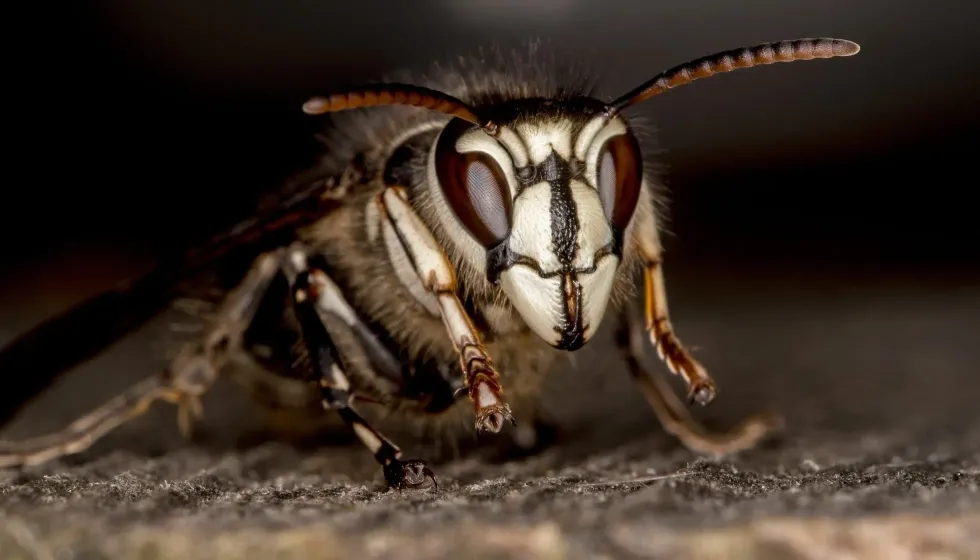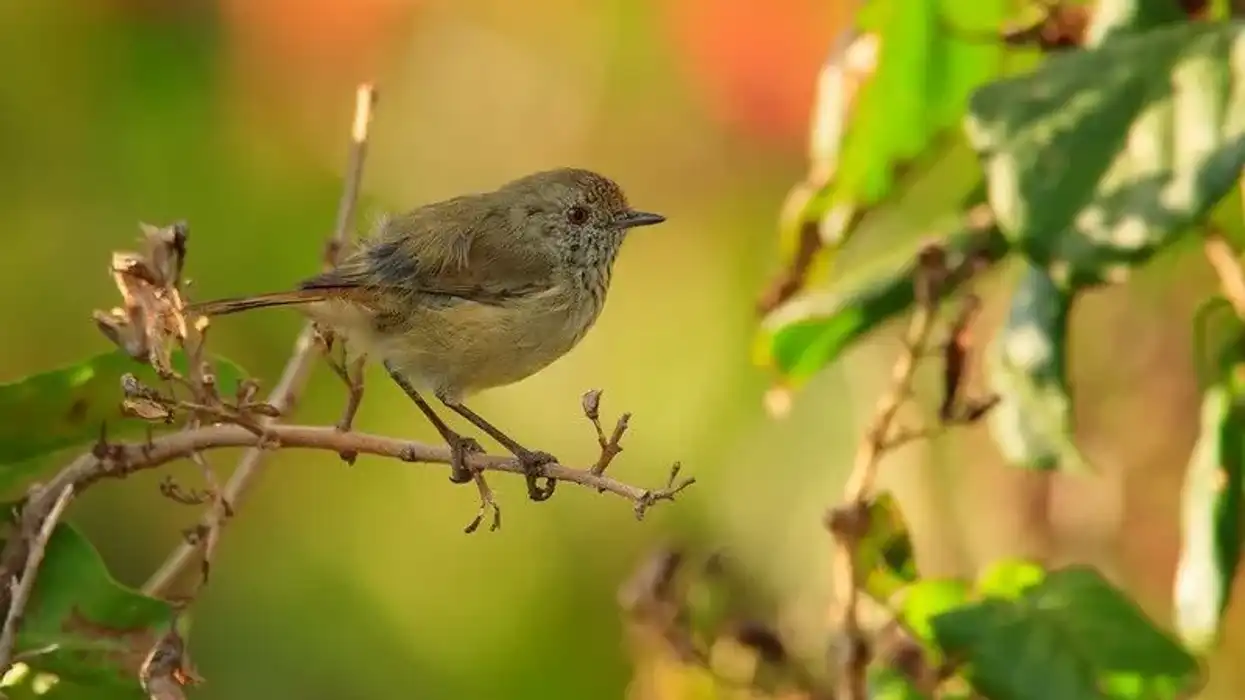The bald-faced hornet (Dolichovespula maculata) is a common stinging insect found all over North America belonging to the cosmopolitan family of wasps, not hornets. These insects are extremely possessive about their nest and their sting is very wicked and causes serious damage.
They prefer building their nest on a high tree branch in the edges of the forests during spring and late summer is their mating season.
These black and white insects live in large numbers together and the queen lays eggs to build the colony as big as possible.
Their diet mostly includes live prey like smaller insects as well as sugary nectars. They have a black and white body with white markings on their lower abdomen and are also called a white-faced hornet, a bull wasp or a white-tailed hornet among others.
They are beneficial for pollination and pest control, but their adversaries are higher. They are more active in summer and during the day as they love the light, so in summer their population increases and their nest removal should be done by a professional.
To know more about these beautiful insects please read on.
If you like reading about various animal facts, then please check out these similar articles on the yellow jacket wasp and the mud dauber wasp.
Bald-Faced Hornet Interesting Facts
What type of animal is a bald-faced hornet?
The bald-faced hornet (Dolichovespula maculata) is a type of eusocial (highest level of societal organization) wasp.
What class of animal does a bald-faced hornet belong to?
The bald-faced hornets are insects belonging to the Insecta class and Arthropoda phylum.
How many bald-faced hornets are there in the world?
Bald-faced hornets are quite common in the United States and parts of Canada. But their exact population is unknown due to a lack of enough research. However, there are usually 400 - 700 workers with one queen in each nest.
Where does a bald-faced hornet live?
The bald-faced hornet builds its own nests and is found all over North America especially in the south-eastern parts of the U.S. and some of the southern parts of Canada as well. They have been mostly seen building nests near the edges of the forests, rocky mountains and during summer in public parks.
What is a bald-faced hornet's habitat?
Bald-faced hornets are known to build aerial nests generally 3 ft - 65 ft above the ground and preferably on branches of high trees or sides hilly slopes.
Their nests are egg-shaped made of a paper-like material that is made from chewed wood fibers mixed with saliva also called 'wasp spit'. Bald-faced hornet nests have layered hexagonal combs with various numbers of cells covered by a grey paper-like envelope.
Like all social wasps, they live in colonies but unlike them, the bald-faced hornets don't reuse their nests, the newer generation rebuilds their own nest with a single queen hornet.
Who do bald-faced hornets live with?
Bald-faced hornets belong to the cosmopolitan class of Vespidae so they are eusocial in nature. They live in large well-organized colonies of egg-shaped nests built by them. In each nest, about 400 - 700 workers live, both males and females and one queen. Queens lay eggs in each cell and provides the larvae with food.
How long does a bald-faced hornet live?
The bald-faced hornet doesn't have a very long lifespan. The males are seen to die after mating and live averagely for 12 - 22 days.
The queens after being fertilized find a shelter and wait throughout the winter and lay the first round of eggs after initiating the nest in spring which hatches into worker hornets.
The adult queen dies with their nest by the end of autumn which gives them an average lifespan of one year. The bald-faced hornet's life cycle depends on its colonies which is typically within 122 - 153 days depending on their location.
How do they reproduce?
Bald-faced hornets are sexually dimorphic (the males and females are visually different in sizes or appearance) and males are haploid (has a single set of chromosomes from one parent) and females are diploid (has two complete sets of chromosomes from both parents). One single fertilized bald-faced hornet queen builds a colony by laying eggs during spring.
The eggs take six days to hatch and then eight days to grow into larvae and another nine or 10 days to become an adult worker hornet.
The workers focus on colony building and all the necessary housekeeping tasks and the queen dedicatedly lays an egg in each cell and rear them until they hatch.
Around 100 - 400 eggs are hatched per season. During late summer the new generation queens and males hatch and fly off to mate and the adult queen dies by the end of autumn with the colony.
What is their conservation status?
The bald-faced hornet species is extremely common in the USA and southern Canada. They are not listed in the IUCN (International Union of Conservation of Nature) Red List of Threatened species. But these killer wasps have recently started invading already endangered American bees and prey on them. Thus bald-faced hornet removal drives through pest control have become more popular.
Bald-Faced Hornet Fun Facts
What do bald-faced hornets look like?

*Please note this is an image of a wasp, the parent species of the bald-faced hornet.
Bald-faced hornets look very similar to their yellow-jacket relatives. It is often also referred to as the white-faced hornet because of its white bald face.
This insect with six feet has a white and black body with white markings or stripes at the end and two slanted lines run from its midsection till its head. Their wings and eyes are usually brown in color and also have segmented antennae.
The workers and queens have almost similar morphologies except the queens are always bigger in size.
How cute are they?
Most people find these bald-faced hornets quite intimidating and scary and not at all cute. But they do look very majestic because of their size and coloring.
How do they communicate?
The bald-faced hornet like most social wasps communicates through vision, touch, chemicals like pheromones, and wing vibrations among each other. The queens and workers communicate with each other about the safety and progress of the nest, location and storage of food, and other housekeeping tasks.
How big is a bald-faced hornet?
The bald-faced hornet is the largest species of the Dolichovespula genus. They are slightly bigger than their close relatives the yellow-jacket wasps.
The workers are generally 0.47 in - 0.55 in (12mm - 14 mm) long and a queen is usually 0.70 in - 0.78 in (18 mm - 20 mm) long. The bald-faced hornet size ratio of workers and queen might differ depending on the location of the colony.
How fast can bald-faced hornets fly?
The exact speed of a bald-faced hornet is not clear but wasps and hornets are fast flyers.
How much does a bald-faced hornet weigh?
The weight of a bald-faced hornet is not known.
What are their male and female names of the species?
The bald-faced hornets don't have any distinguished names for the male and female species, but the male hornets are worker hornets and the female is reared as a queen.
What would you call a baby bald-faced hornet?
The offspring of bald-faced hornets hatch from the eggs laid by the queens and are called larvae.
What do they eat?
The bald-faced hornet is omnivorous species of insect. They typically prefer live prey or sometimes they look for sugary liquids like nectar.
They mostly like to prey on smaller insects like flies, spiders, caterpillars, and more such bugs for their protein. Bald-faced hornets love to prey on bees which is a very good source of protein for their future queens and also for their sweet sugary honey.
The newborn larvae need a more protein-based diet whereas the adult follows more of a sugary diet.
Are they dangerous?
Yes, the bald-faced hornet venom is quite dangerous and they can attack if they feel threatened. These insects are often regarded as professional little killing machines due to their preying habits.
But still, they are one of the less aggressive species of wasps or hornets.
Bald-faced hornet's aggressive behavior only comes out when they sense any kind of threat to their nest and they will attack but unlike most stinging insects, the bald-faced hornet sting only when extremely threatened.
Since it has mild venom which causes allergic reactions and could lead to death in vital cases, and if you ever face a white bald-faced hornet bite, immediate medical treatment is required and highly advised.
Would they make a good pet?
Bald-faced hornets cannot be tamed into domestication, unlike bees. You cannot imagine this species to be pets, so don't ever try to do so. These insects are good pest killers but their sting is venomous and getting stung isn't worth it.
Did you know...
Bald-faced hornets have an excellent memory and are capable of remembering the faces of their previous intruder.
A bald-hornet larva produces this sticky, sweet compound known as Vespa amino acid mixtures (VAAM) and it is good for making energy drinks in Japan.
How long does it take bald-faced hornets to build a nest?
The life cycle of a bald-faced hornet colony is 122 - 153 days and it changes every season. The colony or nest is started by a single dominant queen hornet on a high tree branch in a forest or smaller trees in public parks.
They love making their aerial nests high above the ground preferably between 3ft - 65 ft (1 m - 20 m) approximately. A bald-faced hornet nest is usually 14 in (36 cm) in diameter and 23 in (58 cm) long approximately.
How to get rid of bald-faced hornets?
Bald-faced hornets are quite often referred to as 'murder hornets' as they have venom in their sting, which can kill a human with one or two attacks.
Bald-faced hornet sting reaction is quite painful and stings very badly which causes swelling in the throat, face, and mouth, difficulty in breathing, dizziness, anxiety, rapid pulse, and more. Therefore, if a bald-faced hornet nest is found anywhere near your house or worse in your house, aerosol wasp and hornet spray are quite effective to control the nest.
It is highly advised that you don't do this yourself and let a professional handle the bald-faced hornet nest removal.
Here at Kidadl, we have carefully created lots of interesting family-friendly animal facts for everyone to discover! Learn more about some other arthropods including grasshoppers and house centipedes.
You can even occupy yourself at home by drawing one of our Bald-faced hornet coloring pages.










